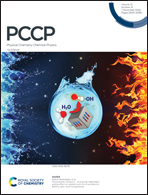A density functional theoretical study on the stability of Pt clusters in MOF-808†
Abstract
Metal organic framework (MOF)-encapsulated metal clusters have shown superior catalytic activity due to geometric and electronic properties of metal clusters, which are largely determined by adsorption sites and sizes and morphologies of encapsulated metal clusters. In the present work, anchoring sites, the stability, and the agglomeration probability of Ptn (n = 1–23) clusters over an MOF-808 framework structure were studied using density functional theory calculations and ab initio molecular dynamics simulation. It has been found that Ptn (n = 1–7) clusters bind more strongly at the Zr6 metal node sites than at the interface and linker sites. Upon adsorption, significant amounts of electrons (+0.92 to +1.96 |e|) are transferred from Ptn clusters to the MOF framework. The agglomeration of single Pt1 atoms at the Zr6 metal node to form a Ptn cluster is unlikely, while the agglomeration at the interface or the linker is energetically feasible. Compared with the single Zr6 node, the bonding of Ptn clusters with two Zr6 metal nodes is weaker, with less electron (+0.12 to +0.89 |e|) transfer. Finally, our calculations show that CO adsorption at the single Pt atom is stabilized at the interface site, preventing its further agglomeration with Ptn clusters between the two Zr6 metal nodes.



 Please wait while we load your content...
Please wait while we load your content...